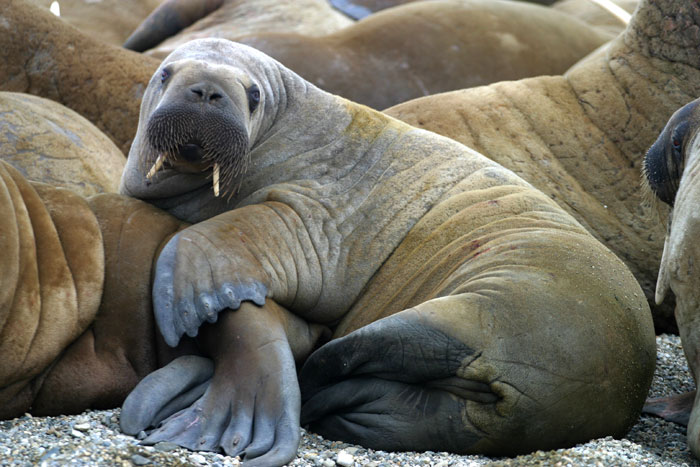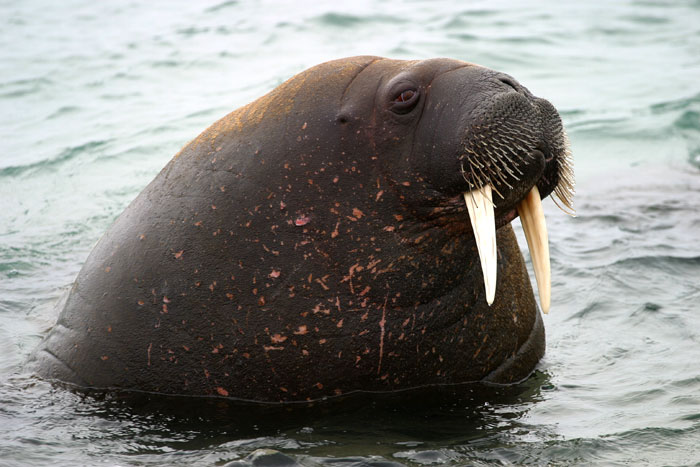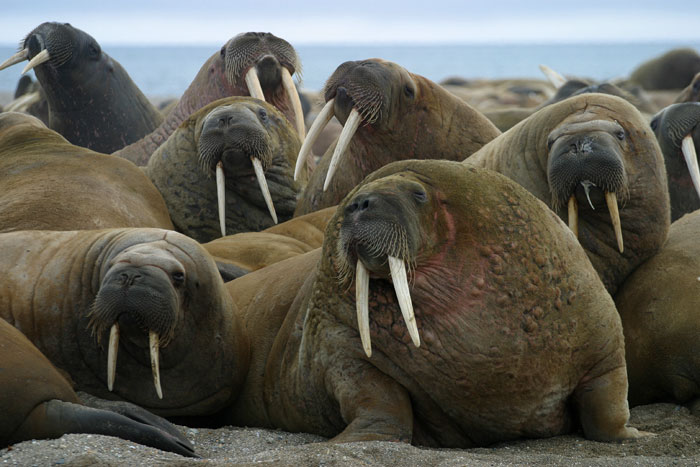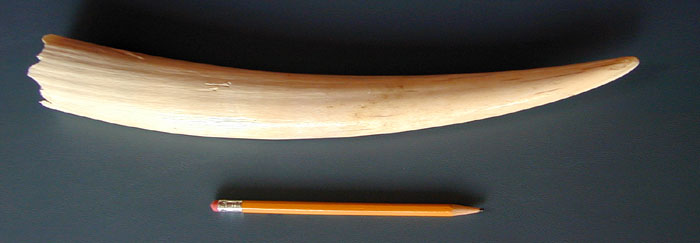The walrus is a distinctive marine mammal with its tusks. (GA image) |
| The walrus was named for ‘toothwalker’ because it often uses its distinctive tusks to help itself drag its body across the ice or land. Formally called Odobenus rosmarus, most scientists consider the walrus to consist of two subspecies – the Pacific walrus (Odobenus rosmarus divergens) and the Atlantic walrus (Odobenus rosmarus rosmarus). The Pacific walrus is larger, darker and much more numerous. |
Resting walrus group of mixed males, females and babies. (GA image) |
| There is no accurate population census for the walrus but it is believed there are over 200,000 Pacific walrus and only a few thousand Atlantic walrus individuals. They have been heavily exploited by man for food, hides, and their ivory tusks. Walruses can be found in most areas of the Arctic Ocean feeding on benthic shellfish. |
Resting walrus group with the author and her husband, Svalbard, August 2003. (GA image) |
| Walruses spend one third of their time on land or pack ice and the other two thirds in the ocean. They appear awkward on land but graceful in the water where they feel most comfortable. A walrus can live for forty years or more and is, indeed, a unique and marvelous creature of this earth. |
Resting walrus group with one member awake. Notice the walrus with its tusks raised as it squints to see who is nearby. Walruses have poor eyesight but are very curious. When groups are asleep and people come near them you must move slowly and quietly so as not to disturb the entire group. One by one they wake up and look around to see what is happening, then go back to sleep. If they are startled they may all rise and stampede to the water ... trampling the babies or young ones. (GA image) |
| Walrus tusks are found on both the male and the female where they grow continually throughout their life. The tusks are used as a symbol of age, sex, and social status. The babies have no tusks when they are born. The tusks of the males are much longer and wider in proportion to their body than those of the female. The males use their tusks as a symbol of their masculinity – turning their heads and thrusting their tusks up in a show to prove their dominance. Tusks are also used as weapons in fighting, to help in walking on land (the toothwalkers) and they have a minor role in feeding. |
Walrus head showing red eye and no external ear (left). Walrus showing typical rumpled brown body (right). (GA images) |
| Walruses have no external ear, an adaptation to the cold (reducing any external appendages). It is just a small hole which is hard to see with all of their wrinkles. The fat body with rumpled brown skin is characteristic of adult walruses. |
Rosy skin showing through their rumpled brown flesh is common on walruses who have been in the sun for some time. (GA image) |
| Rosy skin of sunning adult walruses is typical after several hours in the sun. As walruses age they tend to loose their brown hair so the older adults may appear almost hairless. The color of their skin can change from being very pale to rosy pink. This color change is because of their circulation that is restricted to the outside when they are in cold water (to conserve heat). When they are on land the circulation is restored and they often have a rosy hue. |
Small head, large tusks, and red eyes of the walrus. (GA image) |
| Their rounded, streamlined body makes them well adapted for swimming and to conserve heat. By having a small surface to volume ratio with few external appendages there is a decreased surface area in which to loose heat. Thus the bulbous body of the walrus, small head without any external ear flaps (pinna) gives them a hydrodynamic shape. It is also insulated from the cold by a thick layer of blubber under the skin (up to 6 inches thick). The male walrus lacks any externally visible penis – the walrus penis is internal and supported by a bone called a baculum. |
Walrus baculum (penis bone). (GA image) |
Walrus hind limbs can bend under their massive bodies (left). Close up view of hind limbs under body (right). (GA images) |
| Their forelimbs and hindlimbs are sleek and webbed, like oars. The walrus swims mostly with its hind limbs, using the front limbs as rudders. They are rather slow swimmers averaging only about four and a third miles per hour. But, if they are startled they can swim up to 22 miles per hour. On land, the hind limbs are brought around and under the body (similar to sea lions and fur seals) but the walrus cannot hold up its own weight so it moves on land (or on the pack ice) like an inchworm, thrusting its body forward in small lunges using its limbs but never really getting off the ground. Its thick layer of blubber acts as a cushion on its chest and tummy area. |
A typical male walrus (left). Male walrus tusks in a museum in Norway with the author and her husband for scale (right). (GA images) |
| The male walrus is usually called a ‘bull’ and gets to be over ten feet long and weighs over 2,650 pounds. The full sized adult males may have tusks over three feet long. These older adult males usually develop a cornified chest and shoulder area which aids them in any battles they may have as they lung against their opponent. |
A typical female walrus. (GA image) |
| The female walrus is usually called a ‘cow’ and is smaller than the male with tusks that are smaller – generally not over two feet long. Females only get to eight and a half feet in length and weigh up to 1,800 pounds. |
Walrus resting in shallow water on its tusks with its nose open. (SA image) |
Walrus with nose closed. (GA image) |
| Walruses feed on benthic shellfish like clams, whelks, cockles, and mussels. They dive to depths of 300 feet and can stay down for over ten minutes on the average feeding dive. One dive was clocked at 27 minutes. When they dive to feed their ears close and their nostrils close tightly. Special tissue in their ears allows them to equalize the pressure easily. An adult walrus might feed on 4,000 clams in one day but then rest for up to four days before feeding again. |
Walruses swimming out to greet our boat - one diving behind the greeting party. (GA image) |
| Walruses have special adaptations for diving. They have a larger percentage of blood in their bodies to carry oxygen – about 12 percent of their weight as compared to only 7 percent for humans. Also, their red blood cells (that carry the oxygen) are exceptionally large. In addition, they have lots of myoglobin in their muscles that can store oxygen. When they dive the blood flow is cut off from their skin, extremities and stomach. All of these adaptations allow for an efficient and lengthy use of oxygen stores. |
| After diving, walruses can inflate throat pouches with air so that they can rest at the surface. These unique throat pouches are actually called ‘pharyngeal pouches’ and act like a life preserver. The males use them to make a loud bell-like sound during breeding season. |
Walrus whiskers close up. (GA image) |
| While diving for shellfish walruses use their tusks as sleds and their whiskers (vibrissae) as feelers. They will sled along the bottom of the ocean looking or feeling for their prey. When prey is detected the walrus will stop, swish its head back and forth to dig it out. It uses its vibrissae like ‘chop sticks’ to manipulate it. If the shellfish is too far below the surface the walrus will squirt water forcefully through its tongue and hydraulically drill out the shellfish. |
| Then the walrus will suck out the soft insides of the shellfish. The ability of the walrus to suck out the insides of the shellfish is remarkable as they can do this in a matter of seconds – leaving the empty shell beside the depression it made to dig out the shellfish. Sometimes there is a tough skin on the siphons of the shellfish that remains attached to the empty shells but has been pulled ‘inside out’ by the strong suction power of the walrus. Some calculations show that a walrus can find and eat a shellfish in about six seconds. This speed allows the walrus to consume plenty of food on a dive. |
Mother and baby walrus - notice the short tusks on the baby. (GA image) |
| The walrus has the lowest reproductive rate of all the pinnipeds. The females only have a calf every two to three years. The babies stay with their mother for over two years. Although the males mature at about 10 years of age and the females at about 8, most males do not mate until they are at least 15 and females usually do not give birth until they are around 10 years old. |
Tusk display by a walrus in the water - by throwing their head back and showing their tusks the walrus is announcing its presence and warning others to leave it alone. (GA image) |
Angry tusk display. (GA image) |
| Mature male walruses claim an aquatic territory near a group of resting female walruses. The strongest males get the best territories and keep them by displaying their tusks, growling and lunging at nearby males. These territories are constantly shifting as the ice moves. The males submerge under the water and make calls for a few minutes at a time. At the surface they make clacking sounds with their jaws. It is quite a scene with the males spaced some thirty feet apart – all doing the same thing. Although they make threat displays toward each other there is rarely an injury. |
| The females come to the males, one by one, and join him in the water. The pair will nuzzle each other, dive together and mate in the water. Occasionally they will leave the water to mate on land but the courting occurs in the water. Each male may mate with several females each season but the females only choose one male. Mating is helped in these bulky creatures by the fact that the males have a bone in their penis to aid in mating. Their penis is held internally until reproduction when it is extended by the use of this penis bone (called a baculum). Walruses have the longest baculum of any living mammal. (Baculums are also found in foxes, seals and polar bears). |
 |
| Walrus babies are born in May or June. The walrus has ‘delayed implantation,’ like many other pinnipeds which allows a variety of mating times but the fertilized egg (zygote) waits and implants at the exact time within each female so that the babies are born within a month or so each year. This produces a yearly cycle even though the gestation period is different than a year. Most babies are born as the females are moving north (following the pack ice) to feed. The babies are born with their moustache but not their tusks and are usually about 100 pounds. The babies can swim within minutesof their birth. The females produce very rich milk (30 percent fat) and nurse their babies at sea. They are also known to take excellent care of their babies, protecting them from harm and even carrying them on their back or clutching them to their chest. |
Walruses from afar on a cloudy day. (GA image) |
| The walruses follow the edge of the pack ice each year. They huddle in herds during the winter resting on the ice. If it gets too cold they enter the water (which is often warmer than the air in winter). They must be careful if they are hauled out near a lead (channel of water) that the lead does not freeze over and prevent them from entering the water. The walrus can use is tusks to chip the edges of a breathing hole in the ice to keep it clear and give them access to the water. They also use their tusks to help haul themselves out of the water. If they are caught in the water with ice above them they can break up to eight inches of ice with their head from underneath the ice to create a breathing hole. |
 |
| Every spring the walruses go north to feed, with the melting edge of the pack ice. They feed all summer long. During this time the sexes may separate – groupings of all males may be found on the more southerly land areas hauled out together to shed their hair and skin and sleep. The females make the journey north – giving birth along the way. |
Curious walruses. (GA image) |
| During fall the walruses stay along the edge of the ice as it extends to the south. The walruses who have traveled north (mostly the females and babies) return to the south and the herds are reunited. During the dark, and icy winter the herds huddle together and mating occurs. All the Pacific walruses funnel through the Bering Strait during this yearly migration north and south (up to 2,000 miles). The Atlantic walruses have a certain number of females that do not migrate north each year but stay with a mixed herd. Other Atlantic walruses sexually segregate (like the Pacific walrus) during the summer. |
 |
| The main predators of the walrus are polar bears, killer whales, and humans. Humans have hunted the walrus since the days of the Vikings and early Native Americans. It is the Atlantic walrus that was the hardest hit by humans because the population centers of the world were in their area (northern Europe) for the longest time. By the mid 1800s there were virtually no walruses in Svalbard. Now the walrus has circumpolar protection and is generally hunted only by native populations for dietary, craft or art. The walrus used to be used as a source for meat for the sled dogs of the north – these sled dogs have been replaced by skidoos (snow mobiles) now. The only main problems today are with poachers or native populations who may choose to kill the walrus for its tusks and sell them on the black market. |
 |
| Pollution may be a problem for the walrus. The fatty tissues of the walrus show high levels of some heavy metals and PCBs (polychlorinated biphenyls). In Alaska there are high levels of both cadmium and mercury found in walrus livers. These chemicals may cause developmental problems, cancer, damage to the nervous system and/or reproductive decline. |
| Populations of the Pacific walrus are rebounding nicely. Some 80 to 90 percent of the world’s walruses are Pacific walruses found in the Bering Sea area and the Chuckchi Sea as well as a separate group in the Laptev Sea. |
Walrus range map. Pacific walrus is in lavender, Atlantic walrus is in rose. (NOAA image edited by GA) |
| Populations of the Atlantic walrus are still very low. These animals are found in three separate groups - in the area above Scandinavia (including where they have repopulated Svalbard waters now), on the eastern side of Greenland, and above Canada stretching to western Greenland. |
| For further information I recommend an excellent book by Peter Knudsen entitled The World of the Walrus, published by Sierra Club Books, San Francisco. It has interesting pictures as well as outstanding text. |
|
|

